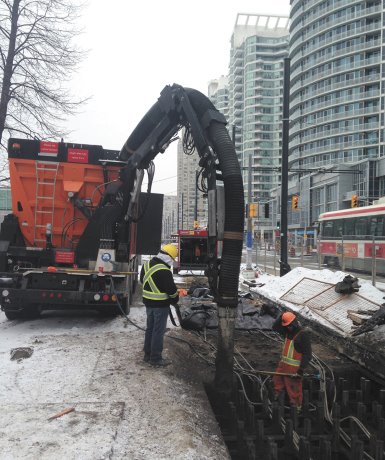Confusion about what constituted a “roadbuilding machine” in Ontario ended on July 1, when the province settled the matter once and for all.
Suction excavators, some of which had previously operated as roadbuilding machines that were unregulated as commercial vehicles, are now required to register for a Commercial Vehicle Operator’s Registration certificate and will fall under the authority of the Highway Traffic Act.
Anticipating that change, Gear Equipment, Inc. of Bradford, Ont. opened in June 2014 as a sales, service and rental business of suction excavators concentrating on dry vac technology. It’s now the exclusive distributor for German manufacturer RSP.
"When we heard the rumblings of changes to the act, we began to think about the anticipated new requirements of gross vehicle weight, axle weight and balanced loads," says Gear president Tom Bottrell.
"As a roadbuilding vehicle, a hydro excavator could balance its loads as it pleased and could fill its tanks with water and soil without concern about legal load limits. They could build the truck as big and heavy as they wanted as long as they stayed within height and width requirements. Dry vac technology allowed us to anticipate the new regulations and implement changes ahead of them."
The current maximum allowable gross weight for new vehicles purchased after Jan. 1, 2017 is 37,650 kilograms. Overweight vehicles purchased prior to 2017 could apply for a one-time grace period of five years for the price of a $440 permit.
"However, many of these grandfathered suction excavators don’t comply with the manufacturer’s axle ratings, or with highway regulations requiring loads to be evenly balanced across all axles," says Bottrell. "As water is used to excavate and the soil water mixture is taken on board, loads can shift from axle to axle."
Gear’s dry vac suction excavators were designed to distribute loads evenly across the axles, balancing fuel tanks, soil tanks and accessories. Better still, dry vac technology allows contractors to take on more soil by both weight and volume by eliminating water.
"On a typical hydro excavation project, 65 per cent of the load is water," says Bottrell. "Using an air spade, the entire load is soil. Many soils are also lighter by volume than water."
Ontario regulations classify a water/soil mixture as non-native material. Once the slurry mixture enters the tank it must be disposed of elsewhere. But soil removed with a dryvac can be left at the site for use as native backfill, or moved offsite with a dump truck. That allows the dry vac to keep working without having to leave the site to dispose of loads.
"We realized that air-only technology had some limitations in the Canadian market," says Bottrell. "Air alone can be ineffective in hard dense clays and cutting through the frost layer in winter. We adapted the trucks to carry their own smaller water system, allowing an operator to cut through the first metre of soil using water. The operator will dump the first mixed load of soil and water, then come back to the site using air only."
Some Gear dry vacs are also outfitted with additional proprietary safety technology, including gas detection systems on the excavation nozzle that sniff out harmful gases and hydro proximity alarms that warn operators they’re nearing a live electrical line.
The current fleet of Gear dry vac vehicles weighs in at slightly more than 41,000 kilograms and were grandfathered under the five-year weight limit grace period.
"However, on July 1, 2022, they’ll be compliant because an onboard digital display system will let operators know that they’ve reached the gross vehicle weight limit," says Bottrell. "The operator may have to leave the site with a tank that isn’t quite full, but with dry vac technology, they’ll be able to leave with a greater amount of excavated soil than a load excavated by hydrovac."











Recent Comments
comments for this post are closed